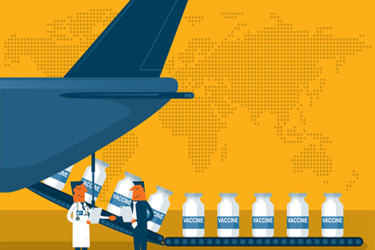4 Key Steps To Build Supply Chains For Later-Stage Clinical Trials In LMICs
By Seth Thompson, head of clinical supply, Bill & Gates Medical Research Institute

At Gates MRI, we develop biomedical interventions that address global health concerns, focusing on diseases such as malaria and tuberculosis that impact low- and middle-income countries (LMICs). Our clinical trials need to evaluate drugs and vaccines and other possible solutions in people who represent the populations most affected by a given disease or indication. We often work closely with our trial partners in LMIC countries to bolster their resources and infrastructure to support the clinical trials and/or movement of clinical trial materials and compounds.
That said, a medical product supply chain needs to be compliant, efficient, robust and resilient — a premise that holds true for a clinical trial supply chain. All clinical supply chain partners are audited and qualified to ensure they can provide the capabilities and resources needed for the studies they serve. Once a clinical supply chain is established, it is our role to work with the partners to identify and mitigate risks that could threaten products and timelines.
While every trial has different needs and parameters that shape its supply chains, building those supply chains almost always involves four key steps. In this article, we will outline those steps and discuss their importance for the success of large-scale international studies.
1. Identify Reliable Sources For Appropriate Commercial Products
In clinical trials, we often need to source and deliver materials and compounds, not just the item we are studying. For example, in a clinical trial evaluating a prophylactic monoclonal antibody to prevent malaria, the study protocol specifies that some participants must first be given pretreatment, consisting of three commercially available anti-malarial products, to ensure that they are not infected with malaria when they enter the trial.
These medicines are commercial products that can be difficult to acquire, most typically purchased by governments in regions with a high risk of malaria. There are very few established processes for independent purchases like ours; many clinical trials include products that require an individualized procurement process. Governments often acquire the malaria drug through agreements with global health authorities and non-governmental organizations like those coordinated by the United Nations. In situations when we are unable to access the processes that governments can, we work through existing relationships within our supplier network to locate where these products are available and in the proper quantity.
In the case mentioned above, we needed to source one product from a South Korean manufacturer, as it was the only entity manufacturing it (an issue our team has encountered with other studies). Once procured, we then needed to secure a separate network of suppliers that could label the pretreatment drugs and distribute them to the trial sites in Uganda.
2. Evaluate Shipping Lanes And Potential Risks
There are many ways to get from Point A to Point B; the suitability of each option to safely transport clinical trial materials must be assessed before selecting a final route, balancing cost efficiency with risk with each evaluation. Transportation by road is less expensive, but we typically minimize its use due to time and security risks, especially in areas where the road infrastructure is poor. While air freight is expensive, it improves our ability to maintain controlled conditions, minimize product loss and damage, and ensure continuity of supply to participants — which can sometimes justify the costs.
Our organization relies on a network of depot partners that have a track record of logistics expertise as well as local knowledge and partnerships that, together, can help identify the most appropriate shipping lanes, airlines, and clearance agents. For example, the most reliable routes to ship from Kenya to Malawi (which is south of Kenya) pass through Ethiopia (which is northeast of Kenya). Although cargo is often “bumped” from flights in Addis Ababa in favor of passenger luggage, the shipping route through Ethiopia, at the time of writing, is the most reliable service available from Kenya to Malawi but not the most efficient, so we must factor potential delays into our overall distribution timelines.
Similarly, Singapore is often a convenient hub for shipments to sites in Asia Pacific and is the most experienced hub in our audited and approved network for shipments to sites in Pakistan. However, in order to send clinical trial materials produced in the USA to trial sites in Pakistan, we must meet the export requirements for both the USA and Singapore and the import requirements for both Singapore and Pakistan, creating added complexity and compliance risks in this route.
3. Identify And Comply With International Import Requirements
To maintain stronger control over our clinical supply chain, we typically rely on one contract manufacturing organization’s distribution network to ship clinical trial materials to our trial sites. The network includes a series of storage and distribution depots, some serving the country in which they are located (known as country depots) and some serving additional countries (known as regional depots). Our supply plans determine how best to use these networks, according to the requirements and infrastructure of the country along with the requirements of each specific study.
Each country has different import requirements, which are typically more demanding for clinical trial materials. It is critical that we understand each country’s requirements, including import licenses, import clearance process, tax liabilities, shipping lanes, and associated timelines.
To plan site delivery and align our clinical operations colleagues on overall timelines for study startup and on potential risks, we map out the typical timeline for each country, including import license application, shipment preparation, flight times, customs clearance, and final delivery. Timelines for regulatory activities, which are generally out of our control (Health Authority and Ethics Committee approvals) are also factored in. The requirements and timelines are then held in a database, referenced when planning new studies and updated as new information becomes available.
4. Maintain Temperature Stability
In addition to delivery timelines, the top priority is guaranteeing that our products remain stable throughout the supply chain. As many of our products are temperature sensitive and we are running clinical trials in countries that experience high environmental temperatures, excessive heat during transportation can be particularly disruptive.
We need to ensure our product remains within allowable temperature ranges throughout the supply chain as well as accurately demonstrate that adherence. To do so, we rely on temperature-controlled shipping cartons — typically using phase change material (PCMs) to absorb and release thermal energy to cool or heat — and temperature monitoring devices, which record and store the indoor climate data throughout the shipping process. These devices increase the cost of shipping but are essential to ensuring the continuity of the supply chain.
Often, our shipping containers can maintain environmental conditions for 96 hours. Yet, planning still must consider the risk of temperature excursions due to flight or customs clearance delays or other situations that arise. Arrangements can be made, prior to dispatch, to ensure that shipments are placed in appropriate climate-controlled storage at airports, thereby extending the time the correct temperature can be maintained within the shipping containers.
Conclusion
Overall, supply chains for clinical trials require extensive planning, a deep understanding of regulatory requirements and international distribution environments, careful risk assessment and mitigation, and close collaboration with our internal study team and external partners. The bigger and more complex the trial and the more challenging the participating countries (in terms of study experience, infrastructure, environmental conditions, and our level of experience as the study sponsor), the more carefully we must undertake all those activities.
About The Author:
 Seth Thompson is head of clinical supply at Gates Medical Research Institute (Gates MRI) and is a clinical supply chain professional with 25 years of industry experience in clinical trial planning and execution focusing on investigational product and related sourcing, production, distribution, and logistics. Thompson builds collaborative relationships with partners and service providers, assembles resilient teams, and cultivates a patient-centric approach to all aspects of clinical trial supply. Prior to joining Gates MRI, Thompson held various clinical supply roles in CMC, clinical operations, and supply chain with Pfizer, J&J, Takeda, and other healthcare and biotech innovators.
Seth Thompson is head of clinical supply at Gates Medical Research Institute (Gates MRI) and is a clinical supply chain professional with 25 years of industry experience in clinical trial planning and execution focusing on investigational product and related sourcing, production, distribution, and logistics. Thompson builds collaborative relationships with partners and service providers, assembles resilient teams, and cultivates a patient-centric approach to all aspects of clinical trial supply. Prior to joining Gates MRI, Thompson held various clinical supply roles in CMC, clinical operations, and supply chain with Pfizer, J&J, Takeda, and other healthcare and biotech innovators.
